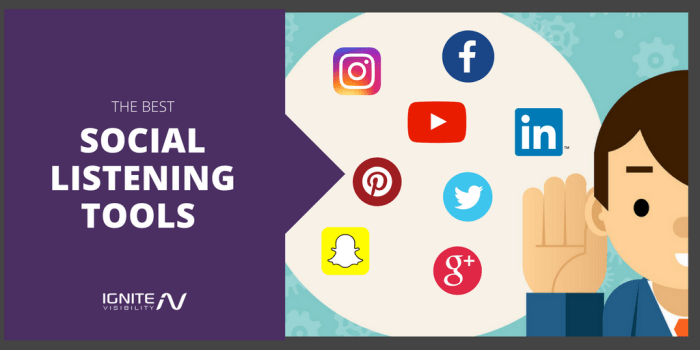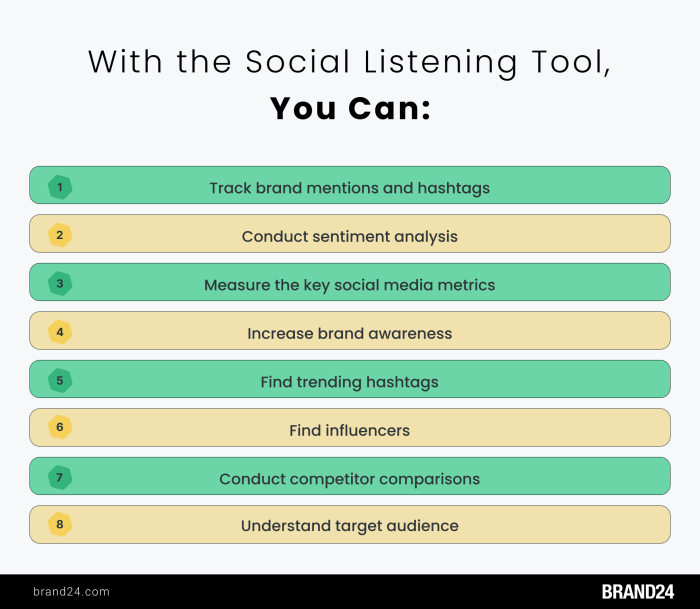Using Social Listening Tools sets the stage for this enthralling narrative, offering readers a glimpse into a story that is rich in detail with american high school hip style and brimming with originality from the outset.
In today’s digital age, the use of social listening tools has become paramount for businesses looking to stay ahead of the curve and effectively manage their brand reputation. From uncovering valuable insights to improving customer engagement, these tools play a crucial role in shaping a company’s success in the competitive market landscape.
Importance of Social Listening Tools
Social listening tools play a crucial role in today’s digital landscape by allowing businesses to monitor, analyze, and respond to conversations happening on social media platforms. These tools provide valuable insights into customer preferences, industry trends, and competitor activities, helping companies make informed decisions and stay ahead of the competition.
Benefits for Businesses
- Identifying customer needs and preferences: Social listening tools enable businesses to gather real-time feedback from customers, helping them understand what their target audience wants and needs.
- Tracking brand mentions: By monitoring social media conversations, companies can track mentions of their brand and products, allowing them to address any issues or negative feedback promptly.
- Competitor analysis: Social listening tools also provide insights into competitor activities and strategies, allowing businesses to identify opportunities for growth and differentiation.
Impact on Brand Reputation Management
Social listening tools are essential for brand reputation management as they allow companies to proactively manage their online presence and address any potential crises before they escalate. By monitoring social media conversations and sentiment, businesses can quickly respond to customer feedback, resolve issues, and maintain a positive brand image.
Types of Social Listening Tools
Social listening tools come in various forms, each offering unique features and functionalities to help businesses monitor and analyze online conversations. Let’s explore some of the different types of social listening tools available in the market.
Brandwatch
Brandwatch is a popular social listening tool that allows businesses to track mentions of their brand across various social media platforms. It provides in-depth analytics and insights to help businesses understand their online reputation and customer sentiment. Brandwatch also offers competitive analysis features, allowing businesses to compare their performance against competitors.
Hootsuite
Hootsuite is another widely-used social listening tool that offers a comprehensive suite of social media management tools. In addition to monitoring brand mentions and conversations, Hootsuite allows businesses to schedule posts, engage with followers, and measure the performance of their social media campaigns. It also provides real-time analytics to help businesses track their social media ROI.
Sprout Social
Sprout Social is known for its user-friendly interface and robust social listening capabilities. It allows businesses to monitor conversations, track s, and measure the impact of their social media efforts. Sprout Social also offers CRM integration, advanced reporting features, and collaboration tools to streamline social media management.
These social listening tools are particularly effective in industries such as e-commerce, hospitality, and healthcare, where online reputation and customer feedback play a crucial role in shaping brand perception and driving business growth.
How to Choose the Right Social Listening Tool: Using Social Listening Tools

When it comes to selecting a social listening tool for your business, there are several important factors to consider. From scalability to customization, finding the right tool can make a significant impact on your social media strategy.
Factors to Consider When Selecting a Social Listening Tool, Using Social Listening Tools
- Cost: Determine your budget and look for tools that offer the features you need within that price range.
- Features: Consider what specific functionalities you require, such as sentiment analysis, competitor tracking, or influencer identification.
- User-Friendliness: Ensure the tool is easy to use and understand, as your team will need to navigate it efficiently.
Importance of Scalability and Customization
Scalability allows the tool to grow with your business, accommodating increased data and users. Customization ensures that the tool can be tailored to your unique needs and goals.
Step-by-Step Guide on Evaluating and Choosing a Social Listening Tool
- Define Your Objectives: Clearly Artikel your goals and what you aim to achieve with social listening.
- Research Options: Explore different tools in the market and compare their features, pricing, and customer reviews.
- Request Demos: Reach out to the providers for demonstrations to see how the tool works in real-time.
- Consider Integration: Check if the tool can integrate with your existing systems and platforms for seamless operation.
- Trial Period: Opt for a trial period to test the tool’s effectiveness and compatibility with your business needs.
Best Practices for Using Social Listening Tools

When it comes to using social listening tools for market research and competitor analysis, there are some best practices to keep in mind to maximize effectiveness and efficiency.
Tips for Effective Use of Social Listening Tools
- Set clear objectives and goals before starting your social listening activities to ensure you are focusing on the right metrics.
- Monitor s, hashtags, and mentions related to your industry, brand, and competitors to stay informed about trends and conversations.
- Analyze sentiment and engagement metrics to understand how your audience perceives your brand and identify areas for improvement.
- Use social listening tools to track the performance of your campaigns and adjust your strategies based on real-time feedback.
Strategies for Customer Engagement and Satisfaction
- Respond to customer feedback and inquiries promptly to show that you value their opinions and are committed to providing excellent service.
- Identify common pain points or issues raised by customers through social listening and address them proactively to improve customer satisfaction.
- Create personalized content and offers based on insights gathered from social listening to enhance customer engagement and loyalty.
- Collaborate with influencers or brand advocates identified through social listening to amplify your reach and connect with new audiences.
Successful Campaigns Driven by Social Listening
One example of a successful campaign driven by insights from social listening is the “Share a Coke” campaign by Coca-Cola. By analyzing social media conversations, Coca-Cola discovered that customers were sharing photos of Coke bottles with their names on them. This led to the idea of personalizing Coke bottles with popular names and encouraging customers to share their personalized bottles on social media. The campaign resulted in increased brand engagement, customer loyalty, and sales.
